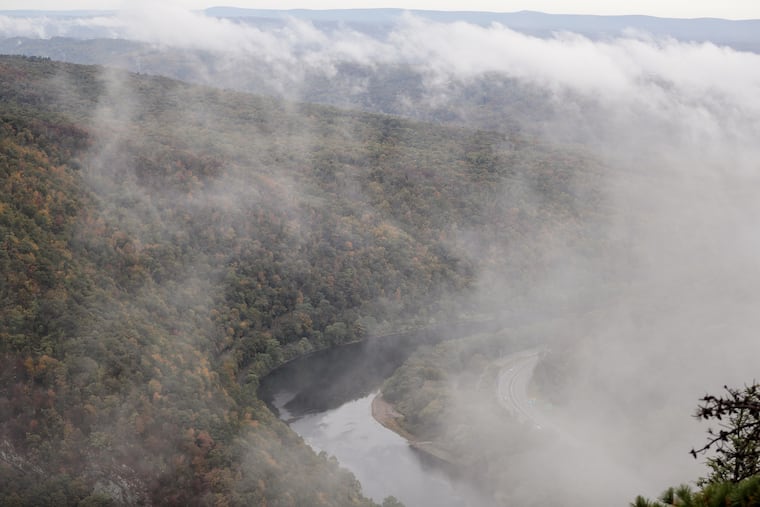To save Delaware Water Gap park from overcrowding, officials eye first-ever entry fee
The National Park Service is proposing a $25 fee per car to enter the park, which officials say is seeing record numbers of visitors, leading to trampled areas and other issues.

Mike Gadomski, 73, frequently hikes the steep trails at the Delaware Water Gap National Recreation Area, 70,000 acres with mountaintop views overlooking the sparkling Delaware River from Pennsylvania and New Jersey.
Over the years, he’s seen the park and its facilities become overcrowded and overtaxed, with people trampling over ecologically sensitive areas and off-road vehicles causing irreversible damage to archaeological sites.
“If possible, I avoid going to the park on weekends and other high-use days just to avoid the crowds,” said Gadomski, a former Pennsylvania park ranger who lives in Sterling, Pa., about 25 miles west of the Water Gap. “The tranquility and peacefulness expected in a national park is lost.”
He won’t object to a National Park Service proposal to charge an entrance fee for the first time, as park officials grapple with safety and environmental concerns, as well as continued budget cuts that have led to a backlog of needed repairs. The plan calls for visitors to pay $15 per person, $25 per car, or $20 per motorcycle for a seven-day pass. Visitors under age 16 would be exempt from the fee, as would those who have paid for yearly passes to national parks, seniors, and members of the military.
“No one likes to pay fees, especially when historically there hasn’t been a fee,” said Gadomski, who has written a book on the park. “But in reality ... the public is demanding more and more from the parks, often specialized costly demands, and the park service is expected to do more with less."
The Water Gap is now among the top 20 national park sites, averaging 3.8 million visitors per year, who flock to popular locations such as Dingmans Falls, Crater Lake, and Kittatinny Point. That’s down a bit in the past few years, but about twice the number who visited the water gap area in 1987, when the park last completed a management plan. Unlike many national parks, the Water Gap is close to two large urban areas, just a two-hour drive of both Philadelphia and New York, adding to its allure.
Thousands of visitors each year who hike or swim at the Water Gap might not know they are on federal land, because most parking lots and trails are free and open, without clearly marked entrances and exits to the park.
The park service is taking public comment on the proposal, so a decision won’t likely come for a few months. The park service already charges some user-specific fees at areas such as Milford Beach or Dingmans Campground. But a site-wide entrance fee would be a first for the recreation area, created in 1975 after a federal government plan to build a dam at Tocks Island collapsed amid uproar over who should control the land and the river.
Jeff Tittel, director of the New Jersey Sierra Club, called the entrance fee proposal “a pretty extensive hit on people.” He said many people visit the park for only a day, so fees meant to cover an entire week could be onerous. He suggests smaller user fees, for example at parking lots.
A park service representative could not be reached immediately for comment Tuesday.
In a draft management plan issued in October that calls for entrance fees, officials said people are avoiding camping fees by setting up their own campsites along the river. Large groups are venturing into areas that are ecologically delicate and even dangerous.
“An increased number of visitors are engaging in risky and unauthorized activities along the creek trails (such as waterfall jumping) that result in increasing need for technical rescues due to visitor injuries,” the National Park Service said in its plan. “The remote nature of the incidents usually makes rescue operations difficult and dangerous. Rescue operations also put a strain on local governments and volunteers who respond to incidents within the park.”
The experience at the Water Gap mirrors a trend at other federal, state and local parks as social media drives visitors to areas previously frequented by a relative few. For example, Philadelphia’s Wissahickon Valley Park has seen an explosion of visitors, many from out of the region.
Park officials face an enforcement problem at the Water Gap because of its size. The park includes a 40-mile stretch of the Delaware River, part of which cuts a pass through the Kittatinny Ridge, forming the Delaware Water Gap at the southern end. The State of New Jersey operates Worthington State Forest at the edge of the park, drawing visitors to areas such as Sunfish Pond and Dunnfield Creek. The Appalachian Trail also runs through the park.
Heavy use also has stressed vegetation in some areas. Officials note the Eastern hemlock, the park’s dominant coniferous tree, has fragile, shallow roots vulnerable to erosion and human trampling. Already 35% of the hemlocks in the park are weakened by the woolly adelgid (Adelges tsugae), an insect from Asia. Heavy storms have also taken a toll.
For his part, Gadomski, the hiker, expects to pay.
“We cannot and must not sell our parks short,” he said. “If Congress will not provide adequate funding and an entrance fee is necessary, then so be it.”